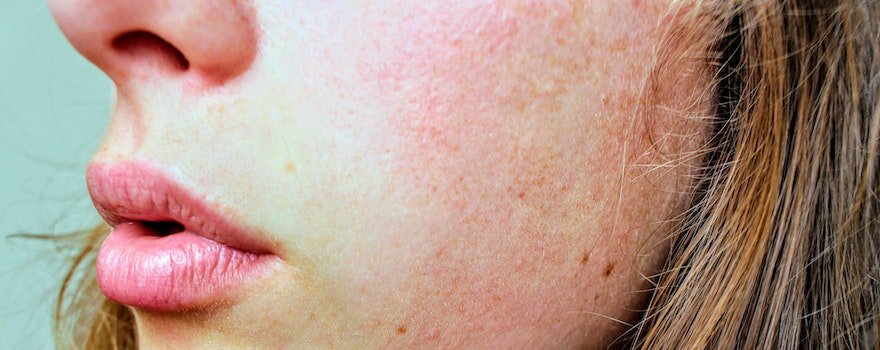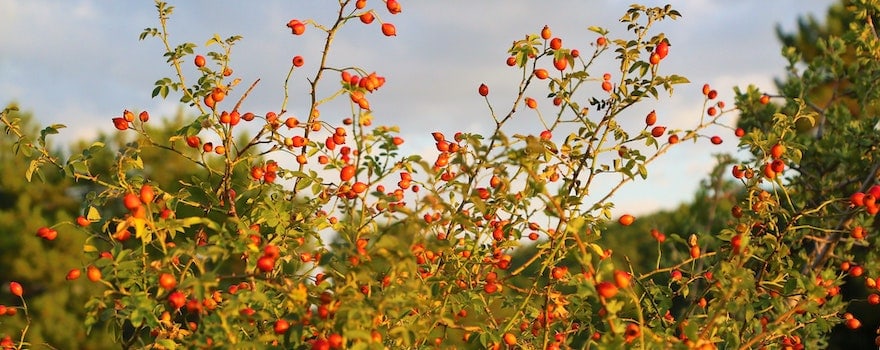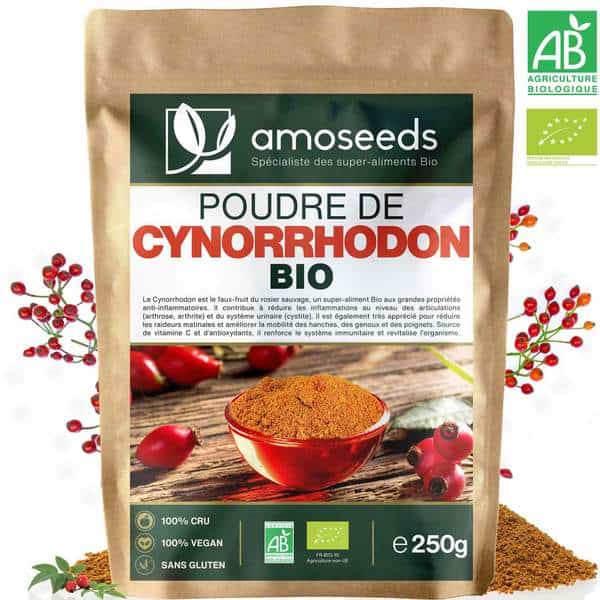BENEFITS OF ROSEHIP
✓ Strengthens and stimulates the immune system
✓ Reduces inflammation
✓ Fat burner
✓ Protects and enhances skin beauty
✓ Potentially anti-cancer
What is rosehip?
The rosehip (also spelled “cynorhodon”) is the fruit of the rosebush, also known as “wild rose” (Rosa canina) and belongs to the Rosaceae family. It is a common shrub in our regions, found throughout Europe, North Africa, and even Western Asia. It can reach a height of 3 meters and has numerous thorns. But the rosebush is best known for its edible red berries, the rosehips, commonly nicknamed “itching powder” in reference to their stinging hairs.
In botany, rosehips are considered false fruits, like cranberries, lingonberries, and strawberries. Thus, they do not result from the fertilization of the flower’s pistil alone but from other parts. Initially, orange, rosehips turn red in autumn. They are fleshy, oval berries about 2 cm in length that can be harvested all winter and are very popular with birds.

Rosehips have a long history behind them. Consumed since prehistoric times, they were made into juice, used for tea, jellies, and jams. Appreciated for their sweet and naturally sugary taste, these fruits were also known for their medicinal properties.
Thus, they were recommended to prevent and treat colds, used as diuretics, and for the treatment of various inflammatory diseases. Health benefits that were later confirmed by modern medicine and scientific research.
Today, rosehips are known to be fruits very rich in vitamin C, which gives them antioxidant and stimulating effects.
They are also recognized for their anti-inflammatory properties, anti-obesity effects, and skin benefits. Finally, recent studies have highlighted rosehip’s potential to fight against certain cancers.
Nutritional Composition
- Amino acids including all 8 essential
- Vitamins: provitamin-A, B1, B2, B3, C, K, E
- Minerals and trace elements: calcium, phosphorus, potassium, magnesium, sulfur, zinc, iron, manganese, sodium
- Sugars: sucrose, levulose
- Fiber
- Proteins
- Tannins
- Antioxidant agents: polyphenols, flavonoids, carotenoids, saponins
- Natural acids: malic acid, citric acid, pectin acid
- Fatty acids: omega-3, omega-6
- Essential oils

Buy organic rosehip: our choice
I recommend amoseeds brand organic rosehip powder.
We recommend (and consume!) amoseeds superfoods because their founders source directly from local organic cooperatives.
Thus, they offer very high-quality products at a low cost, and the customer feedback is excellent (see reviews here).
Remember to use the promo code “DARWIN” at checkout to get 5% off all their products.
❤ I like: The excellent quality/price ratio, organic certification, and positive customer reviews.
★ Customer reviews: 4.9/5
☞ Quantity : 250 g / 50 servings
✔ Promo code -5%: DARWIN
The benefits of rosehip
🛡 Strengthens and stimulates the immune system
Rosehip contains an exceptional amount of vitamin C or ascorbic acid: between 300 and 1300 mg per 100g. Thus, it far exceeds citrus fruits like oranges or even other berries like blackcurrants or goji berries. This vitamin C is mainly concentrated in the fruit’s pulp.
Thanks to this composition, it is ideal for strengthening defenses and stimulating the immune system, especially as winter approaches. Its vitamin C helps prevent and fight against common ailments (cold, flu, temporary fatigue…) and infections. It also has antioxidant effects against free radicals that weaken the body.
Finally, rosehip contains other interesting components to strengthen and stimulate the immune system. It notably contains polyphenols, such as flavonoids, but also carotenoids and saponins. These antioxidant substances are powerful protective agents against the development of diseases.
This study from Alexandru Ioan Cuza University of Iași (Romania), conducted on fruit samples, shows the vitamin C content of rosehip depending on altitude.
🔥 Reduces Inflammation
Consuming rosehip is beneficial for reducing inflammation, especially in cases of arthritis, osteoarthritis, and rheumatoid arthritis. Besides acting on the inflammatory process, it also helps alleviate associated pain and improve joint health.
Like cacao, rosehip contains flavonoids and tannins that act on inflammation and calm the inflammatory response. It also contains vitamins that help regulate the process and reduce joint pain such as vitamin E and B3. Finally, certain minerals and trace elements (potassium, magnesium, manganese…) fight against inflammation and support joint health.
It relieves many symptoms such as morning stiffness or loss of mobility in the hips, knees, and wrists.
This study from RMIT University (Australia), conducted on patients with arthritis, shows the effectiveness of rosehip in reducing pain.
This other study from the Charité University Medical Center (Germany), conducted on patients with rheumatoid arthritis, also demonstrates its effectiveness in improving symptoms.
🏃🏻♂️ Fat Burner
Rosehip is also notable for combating obesity. Its consumption helps to lose weight healthily and reduce body fat, particularly in the abdominal region.
On one hand, rosehip acts on the peroxisome proliferator-activated receptor (PPAR). This protein is involved in metabolism and adipogenesis (formation of fat cells in adipose tissue). It thus limits fat storage in the body.
On the other hand, rosehip improves symptoms associated with obesity. For example, it reduces systolic blood pressure and cholesterol levels. It also prevents common complications in obese individuals such as cardiovascular diseases and type 2 diabetes.
This study from Osaka’s Research and Development Division (Japan), conducted on pre-obese patients, shows how consuming rosehip helps to reduce body fat.
This other study, conducted by the same researchers on mice, shows how rosehip inhibits lipid accumulation in adipose tissue.
🍑 Protects and Enhances Skin Beauty
Rosehip is less known for its benefits on the skin. Yet, they are numerous! It notably helps to prevent premature skin aging, reduce wrinkles, improve elasticity, and maintain skin hydration levels.
Thanks to its high content of vitamin C, carotenoids, polyphenols, and various flavonoids, it has a powerful antioxidant activity. It thus fights against free radicals that cause oxidative skin stress and accelerate aging.
It also contains precious fatty acids beneficial for the skin. Linoleic acid, for example, provides suppleness and elasticity. Oleic acid, on the other hand, strengthens the hydrolipidic film and helps maintain hydration.
Finally, rosehip is an excellent source of vitamins, minerals, and trace elements good for the skin: provitamin A, vitamins C and E, zinc, manganese, magnesium…
This study from Mae Fah University (Thailand), conducted on subjects aged 35 to 65, shows the benefits on the skin of a rosehip cream.
🔬 Potentially Anti-Cancer
Recent studies have highlighted the cancer-fighting potential of rosehip. Indeed, it appears to reduce the proliferation of cancer cells and inhibit the action of protein kinase B (AKT) which promotes their survival in the body.
It owes this property to the vitamin C and antioxidant polyphenols it contains. These exert an anti-proliferative effect on diseased cells and are capable of inducing apoptosis (programmed cell death). Rosehip has proven particularly effective against colon cancer and breast cancer.
This study by the Public University of Navarre (Spain), conducted on cancer cells, demonstrates the beneficial effects of rosehip on colon cancer.
This other study from North Carolina Agricultural and Technical State University (United States), conducted on breast cancer cell lines, demonstrates a significant reduction in their proliferation thanks to rosehip.

How to consume rosehip?
Rosehip as berries
Rosehips have a slightly tangy taste. They are harvested from September and throughout the winter. It is possible to eat them as they are when they are fully ripe and red. The first frosts will make them softer. However, before consuming them, it is necessary to cut them in half and thoroughly wash them to remove the stinging hairs inside.
Fresh or dried berries can also be prepared as syrup, decoction, infusion or tea. Use 3g of rosehips for 200ml of water.
Finally, you can extract the pulp and blend it with a food mill or mixer. Add your rosehip preparation to your soups, creams, sauces…

Rosehip as tablets
Rosehip is also available in tablets and capsules. They contain ground, dried berry powder. It’s an easy-to-find dietary supplement, convenient and tasteless (though the berry flavor is not unpleasant).
To achieve satisfactory results, choose capsules sufficiently dosed with rosehip (300 mg/capsule minimum). Also, prioritize capsules without additives and those that are vegetarian.
Rosehip as powder
Rosehip powder is obtained by pressing dried berries. It’s a fairly natural, minimally processed format that has preserved the various nutrients present in rosehip.
The powder is ideal for preparing fruit juices, smoothies, milkshakes, soups… It can also be added to yogurt or mueslis or used for the making of homemade jellies and jams. Choose rosehip powder obtained by cold pressing, 100% pure, additive-free, preservative-free, and GMO-free.
Rosehip as mother tincture
Rosehip mother tincture is obtained by cold percolation or by macerating the fruits in an alcohol/water mixture. It is a format rich in active compounds but contains a lot of alcohol. Therefore, rosehip mother tincture is not recommended for pregnant women, children, or people with certain health conditions.

Rosehip and medicinal plants
To stimulate and strengthen the body, rosehip can be combined with acerola or camu camu.
To support weight loss, you can combine rosehip with other superfoods like Brazil nuts or griffonia, an appetite suppressant.
Finally, the rosehip/turmeric combination is ideal for reducing inflammation, relieving arthritis, osteoarthritis, and joint pain.
Consume sustainably: choose local, organic, and fairtrade rosehip
✓ Rosehips are easy-to-harvest fruits in nature, starting in autumn. They are often found in hedges, woods, thickets, and shrublands. If possible, opt for wild, selective, and respectful harvesting.
✓ Unfortunately, rosehip is becoming increasingly rare due to the destruction of hedgerows and wild areas. To meet the growing demand, more and more rosehips come from cultivated plants. Preferably select berries that originate from France and are certified organic farming. It’s also possible to find rosehip from fair trade and solidarity sectors.
Dosage
It is recommended not to consume more than 5 g of rosehip per day.
The capsules should be taken with a large glass of water and before meals.
The doses should be taken for a minimum of 3 months to achieve satisfactory results.
- Rosehip berries: 5 g per day
- Rosehip tablets: 3 to 6 capsules per day for 300 mg capsules
- Rosehip powder: 2 to 5 g per day
- Rosehip mother tincture: 15 drops morning and evening
Contraindications and side effects
The consumption of rosehip has certain contraindications:
- As a precaution, rosehip is not recommended for pregnant and breastfeeding women and young children;
- Diabetics, people suffering from a blood clotting disorder, kidney stones, an iron deficiency or excess should avoid consuming it;
- Due to its high vitamin C content, it is not recommended for people with a G6PD deficiency or favism;
- People with a history of heart disease or prone to blood clots should also avoid the consumption of rosehip;
- Rosehip can have interactions with certain medications like aspirin, anticoagulants, and estrogens.
Excessive consumption of rosehip may lead to the following adverse effects:
- Intestinal pain
- Stomach cramps
- Nausea and vomiting
- Diarrhea or constipation
- Headaches
- Sleep disturbances
If you experience any side effects, stop your consumption and consult a doctor.
History, culture, and market of rosehip
The fruits of the wild rose have long been part of the local French customs. In Lozère, for example, rosehips are used to make the famous “gratte-cul” jam. They are also featured in many popular tales and legends.
But the use of rosehip far exceeds the borders of France. Rosehips are also consumed in Sweden, Armenia, Chechnya, and the Netherlands, in soups, teas, juices, or jams.
The consumption of rosehip is not new. Native American tribes, the Iñupiat of Alaska, and the Tanaina Indians had already discovered their taste and nutritional qualities long before us. Today, like many wild fruits, rosehip is making a comeback… and rightly so!
Dossier prepared by Julia Perez and Charlotte Jean
Sources and scientific studies
Ioana Roman, Andreea Stănilă, Sorin Stănilă. Bioactive compounds and antioxidant activity of Rosa canina L. biotypes from spontaneous flora of Transylvania.
Lăcrămioara OPRICA, Cristina BUCSA, Maria Magdalena ZAMFIRACHE, 2015. Ascorbic Acid Content of Rose Hip Fruit Depending on Altitude.
Marc Cohen, 2012. Rosehip – an evidence based herbal medicine for inflammation and arthritis.
S N Willich, K Rossnagel, S Roll, A Wagner, O Mune, J Erlendson, A Kharazmi, H Sörensen, K Winther, 2010. Rose hip herbal remedy in patients with rheumatoid arthritis – a randomised controlled trial.
Akifumi Nagatomo, Norihisa Nishida, Ikuo Fukuhara, Akira Noro, Yoshimichi Kozai, Hisao Sato, and Yoichi Matsuura, 2015. Daily intake of rosehip extract decreases abdominal visceral fat in preobese subjects: a randomized, double-blind, placebo-controlled clinical trial.
Akifumi Nagatomo, Norihisa Nishida, Yoichi Matsuura, and Nobuhito Shibata, 2013. Rosehip Extract Inhibits Lipid Accumulation in White Adipose Tissue by Suppressing the Expression of Peroxisome Proliferator-activated Receptor Gamma.
L Phetcharat, K Wongsuphasawat, et K Winther, 2015. The effectiveness of a standardized rose hip powder, containing seeds and shells of Rosa canina, on cell longevity, skin wrinkles, moisture, and elasticity.
Sandra Jiménez, Sonia Gascón, Asunción Luquin, Mariano Laguna, Carmen Ancin-Azpilicueta, and María Jesús Rodríguez-Yoldi, 2016. Rosa canina Extracts Have Antiproliferative and Antioxidant Effects on Caco-2 Human Colon Cancer.
Patrice Cagle, Tonisha Coburn, Patrick M Martin, 2014. Rosehip (Rosa canina) extracts prevent MAPK and AKT-mediated cell proliferation in African American triple-negative breast cancer cells.




